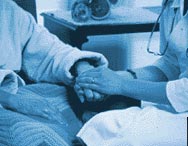| (insert your NIE or newspaper logo here) | Weekly Online LessonOnline Lesson ArchiveGrade Level: 7-10
|
Live and Let Live?
 Terri Schiavo may have believed that her family would fight for
her life at all costs, but she couldn't have imagined how they'd stand
so firmly, for so long, on opposing sides.
Terri Schiavo may have believed that her family would fight for
her life at all costs, but she couldn't have imagined how they'd stand
so firmly, for so long, on opposing sides.
In 1990, Terri suffered from what doctors believe was an imbalance in her body's potassium level. That deficiency caused a failure to deliver oxygen to her brain for about five minutes.
The incident caused permanent brain damage. A court ruled that Terri had become incapacitated, and her husband, Michael Schiavo, was appointed as her legal guardian.
Since then, many—but not all—doctors agree that Terri has remained in a "permanent vegetative state," with no noticeable improvement. She has been kept alive with a feeding tube, as she is not able to eat normally. Plus, she can neither write nor speak a clear word, leaving her thoughts and opinions a mystery.
For 15 years, Terri's husband and her parents have been feuding over how to care for her. Should Terri be allowed to die naturally, or should she be kept alive by mechanical means?
 In 1998, Terri's husband petitioned the court to have her feeding
tube removed—which would essentially starve her to death—believing
that his wife would not have wanted to be kept alive artificially in
such a deteriorated physical and mental condition.
In 1998, Terri's husband petitioned the court to have her feeding
tube removed—which would essentially starve her to death—believing
that his wife would not have wanted to be kept alive artificially in
such a deteriorated physical and mental condition.
Meanwhile, Terri's parents, Bob and Mary Schindler, have fought Michael to keep their daughter alive by whatever means necessary, believing that recovery is still possible.
Finally, on Friday, March 18, 2005—after years of legal, political, and emotional battles—Terri's feeding tube was removed. About a week later, Terri's parents announced that they would not further appeal the decision, but continued to call upon Florida Governor Jeb Bush to help. On Sunday, Gov Bush said there was nothing more he could do.
The feud has drawn a national audience to both sides of the cause, as the case reflects similar decisions that many people must struggle over at some point in their lives.
Private and public discussions have ranged from defining "death with dignity," to choosing who should decide the fate of incapacitated patients, to the government's place in such decisions.
For this week's lesson, you'll be exploring some of these issues in-depth. You'll also get a glimpse into different ways people have coped with death over the years.
Dealing with Death
 Death is an intrinsic part of life, which humans have been coping
with through our entire existence.
Death is an intrinsic part of life, which humans have been coping
with through our entire existence.
When a person dies, the loss affects others physically, mentally, and emotionally. The living are left to struggle over feelings of pain, emptiness, and loneliness.
To help survivors cope with this traumatic change, ceremonies, like funerals, serve as formal acts of laying loved ones—and those personal connections—to rest. These rituals are important to boost the healing process and allow the living to move on.
As you'll soon learn at the Maastricht Natural History Museum in the Netherlands, humans have used many ways to Remember Thy Death (Flash Player required).
Read the introduction, choose your connection, then browse the exhibit using the Timeline. Begin at 100,000BC, and move era by era, to Today.
In what ways did burials change over time? Why were there differences depending on a person's gender or position in the community?
Next, jump down to the Research section. Here, browse through the topics located at the white circles. How do funeral remains help researchers gain insight into local culture, customs, and health conditions?
Dying with Dignity
 Death from injury and illness was quite common
in prehistoric times, but today, many ailments can be cured and wounds
quickly healed thanks to modern medicine.
Death from injury and illness was quite common
in prehistoric times, but today, many ailments can be cured and wounds
quickly healed thanks to modern medicine.
While innovations in medicine can help prolong life and make living more comfortable, death is still inevitable.
For many, one conclusion is clear: When you die is not nearly as important as how you die.
To begin exploring how the dying process affect peoples, let's visit the PBS site, Before I Die.
Browse the Real Life Stories:
In what ways did the difficult health conditions affect the patient and his or her loved ones—emotionally, mentally, physically, and financially? What personal beliefs did each person struggle with in making a decision?
How did each patient's "quality of life" change with worsening illness? What roles, if any, did the law, physicians, or others have in ending or extending the person's life?
As you've learned, coming to terms with death is often a topic that people would prefer to avoid. Unfortunately, such denial keeps people from planning for unforeseen circumstances that could make life a nightmare.
 So,
the last thing to do for this week's lesson is to find out how people
are planning to die by visiting On
Our Own Terms.
So,
the last thing to do for this week's lesson is to find out how people
are planning to die by visiting On
Our Own Terms.
Here, you should browse through the End-of-Life Tools, including A Guide to First Steps, A Guide to Advance Directives, and How to Be with a Dying Person.
Also, take the Self-Assessment of Your Beliefs About Death and Dying.
What are some important things to plan with family members and why? In what ways can family members help support a dying loved one?
Finally, take a tour through Care Options, Final Days, and Therapy & Support.
What are some of the different ways people help live the best they can when awaiting death? How does daily life change during this transition? What exactly is grief? Why do some survivors use the arts to help them cope with the loss?
For an extended study, check out Public Agenda's site that explains how physician-assisted suicide may play a role in a person's Right to Die.
Newspaper Activities
Browse current issues of The Salt Lake Tribune, looking for stories about Terri Schiavo's condition or broader discussions related to death and dying. How is Terri's family coping? Has Terri's case influenced other people in some way? For example, is the case prompting more people to discuss living wills? Is it influencing any state or national laws? Are individuals or groups of physicians or other care givers adjusting their policies in some way? Is hospice care becoming more noticed or talked about in the media or among people you know?
© Copyright 2005
Learners Online, Inc.
